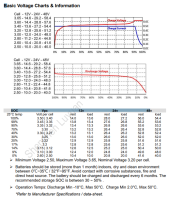I never feel bad in good conversations, you've been great!I will be more than happy if you can provide shunt that has ability to measure 200+ A and it is capable to measure very small current draw. You have probably misunderstood my post. I was not referring to the JK bms issue but your overall expectations that you should expect from JK BMS . And especially if you looking on the shunt that can have tolerance to less than 1% +/- SOC. None of Chinese BMS have sophisticated algorithms specifically designed for one type of chemistry that take in account all variables to present true SOC. Cells drifting when not used and unknown batch of cells in pack are biggest unknown. So my apologies if I did make you feel bad.
Even before doing any discharge work at all, the JK App was showing "6% left" in the pack - sitting on the test bench at a high SOC. The only value my further discharging the battery pack in Trailer testing (down to around 70%) WRT this issue was the confirmation that JK (thank goodness) does not use a ZERO value to shut down discharge of the battery pack. It at least allowed the pack to continue supplying discharge current. But the defect is present and profound - if the new JK (and its cellphone App) can't be fixed to show SOC with moderately decent accuracy in the App, I recommend that the figures should NOT be shown by the App at all.






